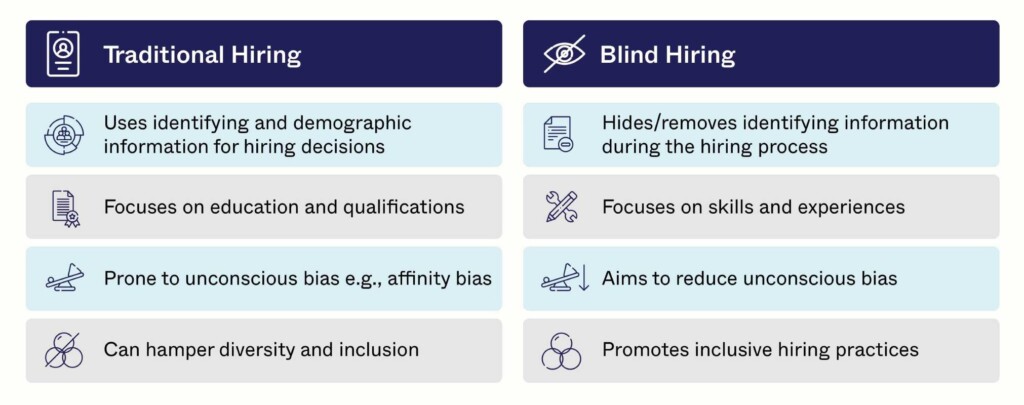Almost two decades ago, a landmark study found that applicants with more “White-sounding” names received 50% more callbacks compared to those with “Black-sounding” names. In a more recent follow-up study, researchers found that not much has changed since then. Applicants with “Black-sounding” names received 10% fewer callbacks from across the board. The applications were comparable; the only difference was their names.
Despite the increased focus on diversity, equity, and inclusion (DE&I) practices, and training, candidates from underrepresented communities continue to face biases. So, what’s the solution? While there is no one way to tackle bias in hiring, the use of ‘blind resumes’ has emerged as a potential solution in recent years. Similarly, blind hiring or recruitment is catching on with promises to establish fairer recruiting methods.
In this article, we break down the concept of blind hiring and how you can introduce it in your organization.
Breaking Down Blind Hiring
Blind hiring is the process of removing identifying information from resumes that may unfairly influence the hiring decision. For instance, a hiring manager might judge candidates more favorably if they completed their education from well-ranked universities compared with those who studied at state colleges or universities. Such implicit bias leads to unfair hiring practices and significantly impacts recruitment.
Identifying or demographic information like name, age, sex, or place of education can trigger unconscious biases. So, the blind hiring method removes or hides this information from resumes and allows the recruiting teams to focus on the individual’s skills, experiences, and capabilities.

Developing a Blind Hiring Process
Beginning a blind hiring process can seem intimidating as it requires you to re-think and modify the entire process. However, instead of scraping the current system entirely, begin by introducing these aspects:
- Redesigning job applications to remove identifying information
At this stage, ensuring that your application is as neutral as possible and that the received applications are not subjected to discrimination is important. At the top, the main elements to target are job descriptions and resumes.
Inclusive job descriptions: Ensure that your job descriptions use inclusive language (i.e., gender-neutral and culturally appropriate terms), are accessible and easy to complete for all, and are compliant with legal guidelines.
Blind resumes: The most popular component of the blind hiring process is to ensure that your resumes are blind. This means removing any identifying or demographic information that can potentially influence the hiring decision. This goes beyond names – think of every element that can trigger implicit bias. For example, a hiring manager who went to Harvard is more likely to favor candidates from Harvard. This is known as affinity bias. Here’s all information you must hide before passing on the resume to the hiring teams:
- Name and other identifying information
- Sociodemographic information like age, gender/sex,
- Educational information like alma mater, GPA
- Hobbies, interests, non-professional affiliations
- Introducing skill-based assessments and interviews
A major thrust of the blind hiring process is its focus on skills instead of educational pedigree. By introducing skill-based assessments and interviews, you can enable hiring managers to focus on the objective abilities of the candidate. These can look like having candidates go through pre-screenings or complete skill-based assessments (e.g., coding tests) down the funnel. You can assess candidates for relevant technical and soft skills using a series of practical questions.
Similarly, adopting these practices during the interviews is also helpful. For instance, asking questions specific to the role instead of emphasizing educational qualifications. Adopt a structured approach; it ensures that all hiring team members are on the same page and the interview does not go off-track.
Here, technology can be your biggest enabler. Investing in the right tools can help you identify the fundamental attributes of your workforce and how to leverage them. Many solutions in the market can help in conducting screenings and skill assessments. These solutions are scalable, too! Invest in tools that enable you to identify what your candidates can bring to the table and use those insights during evaluations.
- Monitoring and assessing your progress
As with any change you implement, tracking your progress is crucial to the process. But how do you do that? Is it any different from measuring success for traditional hiring? It depends on your goals because you also want to assess the implications of your hiring decisions on business outcomes. But it might be helpful to evaluate the success of candidates hired through blind hiring against those who came in through the traditional approach.
While progress manifests over a period of time, in the short term, you can focus on metrics providing information
- Cost of hire – did you hire the right person at the right cost?
- What were the biases in the process (if any)?
- Was the process free from barriers (i.e., everyone who can perform in the role could apply and get through the process)?
Moving forward, you might want to focus on the candidate’s performance in the role.
- What value did they bring to the role?
- In addition, determining the hiring efficacy and the false positive (hiring somebody who does not work out) and false negative (not hiring somebody who would have been great in the role) rate.
Lastly, how do these candidates fare against your DE&I initiatives? And if the process (traditional or blind) meets the criteria of your DE&I objectives and role efficacy. Consider the historical data as a benchmark to compare against blind hiring data.
Does Blind Hiring Really Work?
Blind hiring removes any identifying information from the hiring process that can harm the candidate’s application. This ensures that the hiring teams’ unconscious bias remains in check when they evaluate candidates. Companies use blind resumes and skill-based assessments to promote blind hiring practices. But is it effective?
In theory, removing cues that trigger implicit bias will help reduce bias in practice. However,there is only so much information you can remove from the resume. When candidates and hiring teams meet in person, unconscious biases will come up again. This is to say that without addressing the root cause, these steps might not last long. Along with adopting blind hiring practices, it is vital to evaluate biases within the organization and dismantle them.
Apart from drafting inclusive job descriptions, publishing to the right platforms is vital to bring in more diverse candidates. Joveo can help you do that. Begin your talent-sourcing journey by asking us for a demo! And don’t forget to follow us on Twitter and LinkedIn.















